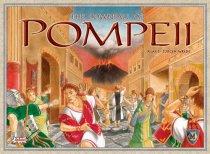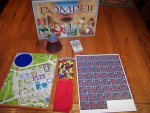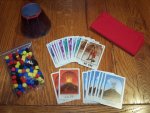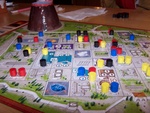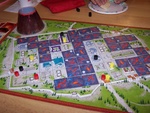
|
The Downfall of Pompeii A game by Klaus-Jürgen Wrede Published by Mayfair Games, Inc. Players: 2-4 Time: 45-60 minutes Reviewed by Susan Rozmiarek |

|
The Downfall of Pompeii, designed by Klaus-Jürgen Wrede was originally published in Germany in 2004 as Der Untergang von Pompeji by Amigo Spiele. Mayfair Games has now published this delightful family game in an English edition. The theme of the game is the destruction of the city of Pompeii by the volcanic eruption of Mount Vesuvius in the year A.D.79. Despite this rather serious sounding theme, the game is actually very fun and light.
Components:
- 127 wooden player pieces in four colors
- 53 Pompeii Cards in four colors and numbered 1 thru 11
- 7 "Omen" Cards
- 2 "A.D. 79" Cards
- 1 flexible plastic volcano
- Cloth Bag
- 45 Lava Tiles
- Game Board depicting the city and its buildings and exits on a grid
- Rules Booklet. The rules are in color and eight pages long with numerous illustrations and examples. They are, for the part, very clearly written.
The components are of very high quality. The cards have the linen weave finish that I prefer and the Lava Tiles are thick and have the same finish. The flimsy paper volcano from the original edition has been replaced with stiff but flexible plastic. It seems very sturdy.
Game play:
The game has two distinct phases. During the first phase, players take turns placing their people (playing pieces) in the buildings in the city. Eventually, the volcano erupts to start the second phase. Now players race against time to save their people by moving them out of the city and avoiding the flowing lava.
Players each get a set of playing pieces in one color. The number they get varies from 25-36 depending on the number of players. They also start with a hand of four, randomly dealt Pompeii Cards. The draw deck will consist of Pompeii Cards with the 7 Omen and 2 A.D 79 Cards shuffled in. Preparing this deck at the start of the game is rather fiddly and the only part of the rules that I found confusing. The important end result of the preparation is that the second A.D. 79 Card is shuffled into the bottom 10 or 15 cards of this deck. This card is very important as it will signal the start if the second phase when it is drawn. Finally, the volcano is assembled and placed on its designated spot on the board and the Lava Tiles are put into the cloth bag. The game is now ready to begin.
First Phase: New Citizens Move to Pompeii
In this phase, players simply take turns playing a card from their hand, placing one (and possibly more) of their people on an open spot in a building on the board whose number matches that of the card played, and then drawing a new card from the deck to add to their hand. The goal of this phase is to get as many of your people on the board as you possibly can, hopefully near city gates.
The placement rules are what make this phase of the game interesting. Most of the buildings on the board have a unique number and are of one of four different colors. Each building is made up of one or two sections and each section has spots to place one, two, or three people. In addition to the colored buildings, there are also numerous "neutral" buildings scattered around the board. The Pompeii Cards each have a number and color that corresponds to a building on the board. When a player plays a card, he places one of his people in an empty spot in the corresponding building. The neat thing is, once the first A.D. 79 Card is drawn, if there are other people already in that particular section of the building, he gets to place additional "relatives," equal to that number of others, on the board in another section of the same building, another building of the same color, or in a neutral building. These other placements do not trigger more relatives so there are no chain reactions. Since you'll want to get as many people on the board as possible, this encourages some hand management as you'll want to save certain cards to play once that building starts to fill.
There are also Omen Cards in the deck. When a player draws one of these at the end of his turn, he immediately plays it and chooses another player's person on the board and tosses it into the volcano and out of the game. We like to humorously refer to these poor wretches as "sacrifices." The player who drew the Omen Card gets to draw another card. In our games, we usually choose our victims based on which player had the most people on the board.
As I said earlier, there are two A.D. 79 Cards in the deck. When the first one is drawn, nothing happens except relatives can now be placed; the volcano is just rumbling. This is simply a warning of the impending disaster. When the second A.D. 79 Card is drawn, the volcano erupts! Players immediately discard all of their cards and put any unplaced people into the box and out of the game. The second phase now begins.
Second Phase: Run for Your Lives!
As in the first phase, turns are very simple. At the start of the phase, players take turns drawing a Lava Tile from the bag and placing it on the board. After six Lava Tiles have been placed, players continue to draw and place a Lava Tile on the board on their turn but in addition they also move up to two of their people. The goal of this phase is to get as many of your people out through the city gates as you can.
Placing Lava Tiles: Each Lava Tile has one of six different symbols on it. Each symbol is depicted on a space on the board which designates where the first matching Lava Tile must be placed. After that, Lava Tiles must be placed orthogonally adjacent to another tile with a matching symbol. The fun part is, when a tile is placed in a space containing people, those people are all tossed into the volcano. This creates some interesting dilemmas as placing tiles so that they kill as many of your opponent's people as possible often brings the lava flow dangerously close to your own.
Moving people: Players must move two of their people. The only exception is that if they move a person that starts alone on a space, they may move him twice. Movement is always orthogonal. The movement rules are very simple yet clever and have been used in other games, such as Emerald. Each person (playing piece) can move a maximum number of spaces equal to the total number of people in the space from which the moving person started. This creates many tactical possibilities as players try to set up their people to move longer distances in one turn. Players collect in front of them the people they have moved through city gates and "saved."
The game ends when the last Lava Tile is played or when no people can be moved out of the city due to blocked exits. Anyone left in the city is tossed into the volcano to a fiery death! The player who has saved the most of his people wins the game. Ties are broken in favor to the player with the fewest people in the volcano.
Comments:
Pompeii seems to work best with three or four players.
With two players, it seemed rather dull, even though players have more control.
With the addition of more players and more turns before you get yours, there is a lot more tension and fun, at least for me.
This is a not a game to be taken too seriously.
Experienced gamers are likely to find some of the mechanisms to be familiar and the decisions to be rather simple in this game. When played in a lighthearted manner though, it is a great longer filler. My first playing was at a convention with a group of serious gamers that had a lot of fun with lots of "smack" talk and sound effects as people were thrown into the volcano. While there is a good bit of picking on other players in this game, it is mostly good-natured and there is plenty of opportunity for revenge. Where the game really shines though, is as a family game or when introducing new folks to euro-style games. Simple mechanisms such as those in Pompeii seem very original and clever when one first experiences them. I have enjoyed teaching this game to new gamers because so far, all have been quite "wowed" by it. Indeed, I can remember being a new gamer myself and it was games like Pompeii that drew me into the hobby. So, I can easily recommend it as a gateway game. Since my kids also enjoy it as well, my copy of Pompeii will probably continue to see a lot of play in the future.
| Other Web information: |
This page viewed
E-mail Ed Rozmiarek with questions or problems concerning this page.
Copyright © 2006, Ed & Susan Rozmiarek. No portion of this website may be reproduced or copied without the consent of Ed or Susan Rozmiarek.
